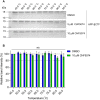A superior loading control for the cellular thermal shift assay
- PMID: 35461337
- PMCID: PMC9035151
- DOI: 10.1038/s41598-022-10653-7
A superior loading control for the cellular thermal shift assay
Abstract
The cellular thermal shift assay (CETSA), as a method to determine protein-ligand interaction and cellular protein modification, has rapidly become routine laboratory practice. However, current options to determine that (1) sample was loaded in each lane of the analysed western blot and (2) the amount loaded was equal, are suboptimal. Here, we report that the αC-terminal fragment of the amyloid precursor protein (APP-αCTF), detected in several wild-type mammalian cell lines, is a highly stable, soluble protein equally present from 4 to 95 °C. We demonstrate that the level of traditional loading controls (vinculin, GAPDH, β-actin, heat-shock chaperone 70 and superoxide dismutase-1) are all temperature sensitive. Additionally, both APP-CTFs (α and β) behaved similarly upon temperature exposure while APP-βCTF levels were not influenced by the presence of a binding ligand either. This emphasises that these proteins can be used as a loading control in the unlikely event of off-target binding during ligand screening. A working example is also presented for mitogen-activated protein kinase kinase in the presence of two inhibitors, PD184352 and U0126, where APP-αCTF was used to normalise the data across experimental replicates. A reduction in data variance and standard deviations was observed after normalisation. Conclusively, APP-αCTF is a superior CETSA loading control that can be used as a standard for this technique.
© 2022. The Author(s).
Conflict of interest statement
The authors declare no competing interests.
Figures





 ]) (C), calculated by setting the highest intensity for each data set as 100% and the curve generated using the Boltzmann sigmoidal equation are shown with (D) the mean aggregation temperature (Tagg) ± SD, pre-normalised (open symbol) vs normalised (N—solid symbol) (n = 3). One-way ANOVA with Tukey’s post-hoc was performed where ns, not significant; **p ≤ 0.01; ****p ≤ 0.0001. See supplementary information file, raw data images for full-length western blots.
]) (C), calculated by setting the highest intensity for each data set as 100% and the curve generated using the Boltzmann sigmoidal equation are shown with (D) the mean aggregation temperature (Tagg) ± SD, pre-normalised (open symbol) vs normalised (N—solid symbol) (n = 3). One-way ANOVA with Tukey’s post-hoc was performed where ns, not significant; **p ≤ 0.01; ****p ≤ 0.0001. See supplementary information file, raw data images for full-length western blots.Similar articles
-
Phosphorylation of amyloid precursor carboxy-terminal fragments enhances their processing by a gamma-secretase-dependent mechanism.Neurobiol Dis. 2005 Nov;20(2):625-37. doi: 10.1016/j.nbd.2005.05.004. Epub 2005 Jun 3. Neurobiol Dis. 2005. PMID: 15936948
-
MEK inhibitors suppress beta-amyloid production by altering the level of a beta-C-terminal fragment of amyloid precursor protein in neuronal cells.FEBS Lett. 2010 Aug 4;584(15):3410-4. doi: 10.1016/j.febslet.2010.06.038. Epub 2010 Jun 30. FEBS Lett. 2010. PMID: 20600008
-
Huperzine A regulates amyloid precursor protein processing via protein kinase C and mitogen-activated protein kinase pathways in neuroblastoma SK-N-SH cells over-expressing wild type human amyloid precursor protein 695.Neuroscience. 2007 Dec 5;150(2):386-95. doi: 10.1016/j.neuroscience.2007.09.022. Epub 2007 Sep 14. Neuroscience. 2007. PMID: 17945434
-
Impaired autophagy and APP processing in Alzheimer's disease: The potential role of Beclin 1 interactome.Prog Neurobiol. 2013 Jul-Aug;106-107:33-54. doi: 10.1016/j.pneurobio.2013.06.002. Epub 2013 Jul 1. Prog Neurobiol. 2013. PMID: 23827971 Review.
-
Does Intraneuronal Accumulation of Carboxyl-terminal Fragments of the Amyloid Precursor Protein Trigger Early Neurotoxicity in Alzheimer's Disease?Curr Alzheimer Res. 2019;16(5):453-457. doi: 10.2174/1567205016666190325092841. Curr Alzheimer Res. 2019. PMID: 30907322 Review.
Cited by
-
Screening the Pandemic Response Box identifies novel ligands of the Staphylococcus aureus protein arginine kinase, McsB.Mol Biol Rep. 2025 May 6;52(1):446. doi: 10.1007/s11033-025-10545-9. Mol Biol Rep. 2025. PMID: 40327182 Free PMC article.
-
Fluorescent Chiral Quantum Dots to Unveil Origin-Dependent Exosome Uptake and Cargo Release.ACS Appl Bio Mater. 2024 May 20;7(5):3358-3374. doi: 10.1021/acsabm.4c00296. Epub 2024 May 8. ACS Appl Bio Mater. 2024. PMID: 38717870 Free PMC article.
-
Synergistic effect of inhibiting CHK2 and DNA replication on cancer cell growth.Elife. 2025 Jan 31;13:RP104718. doi: 10.7554/eLife.104718. Elife. 2025. PMID: 39887032 Free PMC article.
-
A high-throughput screening campaign against PFKFB3 identified potential inhibitors with novel scaffolds.Acta Pharmacol Sin. 2023 Mar;44(3):680-692. doi: 10.1038/s41401-022-00989-1. Epub 2022 Sep 16. Acta Pharmacol Sin. 2023. PMID: 36114272 Free PMC article.
-
SGLT2 inhibitors activate pantothenate kinase in the human heart.bioRxiv [Preprint]. 2024 Jul 27:2024.07.26.605401. doi: 10.1101/2024.07.26.605401. bioRxiv. 2024. PMID: 39091820 Free PMC article. Preprint.
References
Publication types
MeSH terms
Substances
LinkOut - more resources
Full Text Sources
Medical
Research Materials

